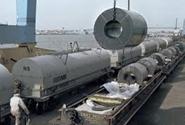Steel Products Prices North America

CRU Aluminum: Risks to Russian Supply From the Alumina Perspective
Written by Greg Wittbecker
May 1, 2022
By Greg Wittbecker, Advisor, CRU Group
Since the outbreak of the war in Ukraine, the aluminum market has fixated on potential sanctions on Russia’s 3+ million metric tons of annual exports. So far, those sanction have not materialized.
Several major players have announced their intention to suspend new business with Russia. Emphasis on “new business.” Others are taking a pragmatic approach, suggesting that they will fulfil existing contractual obligations and let them run to term.
![]() Business as Usual Until Q4 2022
Business as Usual Until Q4 2022
Many of these contracts are annual, hence there is a “grace period” until Q4 2022 – when it will be decision time for 2023.
The most extreme example of extended contract exposure is Glencore, whose contract with UC Rusal runs through 2024, with an optional year through 2025. Glencore is expected to exercise that option.
Looking ahead to 2023, it is increasingly looking like publicly traded companies with highly visible ESG standards will NOT be taking on new business with Russia. The optics for these companies do not justify new business. So “self-sanctioning” is the new buzzword for how the aluminum market may manage the situation unless politicians intervene.
While this handicapping of export sanctions continues, one thing has NOT changed. That is Russia’s problem with securing enough alumina to maintain primary production.
Lack of Alumina Could force Russia’s Hand
UC Rusal have an alumina problem that has persisted since the onset of the war in Ukraine. First, their solely owned, Ukrainian alumina refinery has shut down. That deprives Russia of 1.7 million tons of supply.
Second, the Australian government has blocked exports of alumina from Rusal’s 20% stake in Queensland Alumina Limited (QAL). That cuts off another 1.3 million tons of supply.
In aggregate, this loss of 3 million tons of alumina = 1.5 million tons of primary aluminum output.
You will recall that our early analysis of this problem several weeks ago suggested China could come to the rescue, shipping alumina into Russia in exchange for metal.
That has not happened. Our view is that China’s zero Covid policy and the serious disruption to port activity has hampered those efforts. We understand that 50,000 tons of alumina might have gone out to Russia, although it has not shown up in any trade statistics thus far.
China has also not elected to ship any of its Indonesian-produced alumina directly into Russia.
Some observers speculated that Rusal might have been living off accumulated alumina inventories at its smelters to maintain production. That may have been true for the first 60 days of the war. But a day of reckoning now approaches. Outside of China, no primary smelters carry inventories of alumina higher than 60 days. It is not practical to do so since alumina is highly hydroscopic. Most alumina is stored in upright storage tanks or bins. Combine this storage technique with hydroscopic properties, and you have a looming problem with stocks that turn into cement if not rotated quickly.
Day or Reckoning Approaching
CRU attended a bauxite and alumina conference this week in Miami, and the situation in Russia was a key topic. The consensus was that production curtailments were inevitable. It now boils down to a matter of degree.
CRU had conservatively estimated 250,000 tons of cuts coming from Rusal’s smaller smelters in the western Russia (Kandalasksha, Volkov and Novokutznetsk). Talks with well-placed sources suggest that the cuts could be more severe. These curtailments rationalize production down to (1) supporting domestic demand (~ 1 million tons) and (2) satisfying requirements of the Glencore contract.
This would mean curtailments of more than 1 million tons.
The view is that these curtailments and the announcement of the same have become more pressing because UC Rusal is a listed company in Hong Kong. These production cuts are clearly a material change in the condition of the company. As such, Rusal would have a reporting obligation to the Hong Kong Stock Exchange, and a failure to report this in a timely matter would be highly damaging to the company.
The LME and the physical markets are not ready for this, having assumed that the “grace period” for exports meant that threat had been delayed for up to 6 months. It is reasonable to assume that news of a major Rusal cutback could inspire another rally in LME prices, which have taken a hit in the past two weeks due to rising fears about demand destruction. Russian curtailments remind us that the supply side remains treacherous.
Request more information about this topic.
Learn more about CRU’s services at www.crugroup.com
Greg Wittbecker
Read more from Greg WittbeckerLatest in Steel Products Prices North America

September Import Share of US Sheet and Plate Markets
Imported sheet and plate products arrived at US ports at a slower clip in September, accounting for a lower share of the domestic market for the third straight month. That’s according to a Steel Market Update analysis of import data from the US Commerce Department and domestic shipment figures from the American Iron and Steel […]

US Apparent Steel Supply Falls Further in September
US apparent steel supply eased further in September, down 8% from August to 8.29 million net tons, according to data from the US Department of Commerce and the American Iron and Steel Institute (AISI). As the lowest monthly figure since February 2021, this was a 19-month low. September supply was 10% below the average monthly rate […]

Northwest Pipe Reports Sharply Higher Q3 Results
Engineered pipe and tube producer Northwest Pipe Co. posted sharply higher profits for the third quarter ended Sept. 30. The Vancouver, Wash.-based company said the boost was driven by strong demand and increasing backlogs from its engineered pipeline systems and precast products, according to earnings data released on Tuesday, Nov. 8 All told, Northwest Pipe posted net […]

SMU Price Ranges: Flat-Rolled Steel Falls (Yet Again)
Sheet prices fell across the board again this week as the slow grind lower that we’ve seen since last spring continued to gain speed. Hot-rolled coil prices fell $30 per ton ($1.50 per cwt) week-over-week. Declines in coated products were more pronounced, with cold rolled down $55 per ton, galvanized down $35 per ton, and […]

US Steel Exports Slip 10% in September
US steel export volumes shrunk 10% from August to September, according to the latest US Commerce Department data. 723,000 net tons of steel products exited the country during the month, now the fourth-lowest monthly export rate over the past year and a half. Recall that exports levels in August were at the third-highest monthly rate […]
